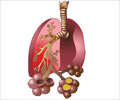The new drug target sheds insights into strategies to fight drug-resistant S. pneumoniae, stated research.

Fomepizole Antidote for Pneumonia
Fomepizole, the FDA-approved drug, disrupts activity of the enzyme alcohol dehydrogenase in the bacteria. The mice were infected intratracheally with the multidrug-resistant clinical isolate S. pneumoniae serotype 35B strain 162–5678, which has high resistance to erythromycin. Notably, the S. pneumoniae 35B serotype has been reported as an emerging multidrug-resistant serotype in clinical settings. Eighteen hours after infection, the mice were given a single injection of erythromycin, with or without fomepizole. “Fomepizole, or other drugs that inhibit bacterial metabolism, have potential to dramatically increase the efficacy of erythromycin and other antibiotics, respectively, in vivo,” said Carlos Orihuela, Ph.D., professor and interim chair of the UAB Department of Microbiology.‘New drug target to fight against pneumonia due to infections by Streptococcus pneumoniae has been identified. ’





A broad foundation of basic research preceded this proof-of-principle experiment. S. pneumoniae relies on fermentation and glycolysis to produce energy. During fermentation, pyruvate is converted to lactate, acetate and ethanol, and NADH is oxidized to regenerate NAD+, which is needed for glycolysis. Accordingly, maintenance of an available NAD+ pool, necessary for redox balance, is vital for sustained energy production, bacterial growth and survival.
Orihuela and UAB colleagues made S. pneumoniae mutants in five enzymes involved in fermentation and NAD+ production, and they found, in general, that the mutants had impaired metabolism. Two of the mutants, one for lactate dehydrogenase and one for alcohol dehydrogenase, had stark decreases in intracellular pool of ATP, the energy molecule of living cells. The other three mutants had significant, but more modest, decreases.
Pneumonia: Facts & Figures
Globally, more than 3 million individuals are hospitalized due to pneumococcal disease annually, and hundreds of thousands die as a result. Increases in multidrug-resistance in the bacteria Streptococcus pneumoniae have made it the fourth-leading cause of death associated with antibiotic resistance.NAD+/NADH redox imbalances in the mutants generally interfered with production of S. pneumoniae virulence factors and colonization in the mouse nasopharynx. Some of the mutations influenced susceptibility to antibiotics, as tested with three antibiotics, including erythromycin, that interfere with protein synthesis, two antibiotics that disrupt cell wall synthesis and one antibiotic that targets DNA transcription.
Researchers found that treating a wildtype S. pneumoniae, which did not have mutations in alcohol dehydrogenase or the other enzymes, with fomepizole alone caused redox imbalances. In vitro tests showed that treatment of S. pneumoniae with fomepizole enhanced the susceptibility to antibiotics, including fourfold decreases in the minimal inhibitory concentrations of the antibiotics erythromycin and gentamicin.
Advertisement
“Our results indicate that the blocking of NAD+ regeneration pathways during infection is a way to increase antibiotic susceptibility in drug-resistant gram-positive anaerobic pathogens,” Orihuela said. “This has clinical potential with regard to microbial eradication and treatment of disseminated infection.”










